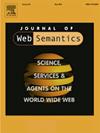Two ontology design patterns in the domain of collections
IF 3.1
3区 计算机科学
Q3 COMPUTER SCIENCE, ARTIFICIAL INTELLIGENCE
引用次数: 0
Abstract
Collections are objects used to arrange, into a single unit, multiple data items that form a natural group. Different types of collections exist, due to different constraints based on whether or not they impose an order on their elements and whether or not they allow repetition of elements. Any of them are easily found in several domains of our everyday life. For instance, a deck of cards, the prime divisors of a number or the teams that compete in a championship can be seen as a collection. Thus, an effective modeling of collections is a recurring issue in information management.
In the ontology design field, recurring modeling problems can be addressed by the use of Ontology Design Patterns (ODPs). In the case of collections, ODPs have been proposed for representing sequences, lists, sets and bags. However, none of these patterns are completely adequate for representing collections of ordered elements without repetition. In this paper we present an ODP for representing that notion, which we have named Permutation. Moreover, another ODP named ListOfPermutations is also introduced, which allows to represent how the order of a Permutation varies along time. Because not all constraints required by these ODPs can be represented in OWL 2, SHACL shapes have been used in their definitions.
集合领域的两种本体设计模式
集合是一种对象,用于将构成自然组的多个数据项排列成一个单元。不同类型的集合存在不同的约束条件,这些约束条件基于集合是否对其元素施加顺序以及是否允许元素重复。在我们日常生活的多个领域中,都能很容易地发现这些集合。例如,一副扑克牌、一个数字的素除数或参加锦标赛的队伍都可以看作是一个集合。因此,对集合进行有效建模是信息管理中经常出现的问题。在本体设计领域,经常出现的建模问题可以通过使用本体设计模式(ODPs)来解决。就集合而言,已经提出了用于表示序列、列表、集合和包的 ODPs。然而,这些模式都不能完全胜任表示无重复的有序元素集合。在本文中,我们提出了一种用于表示这一概念的 ODP,并将其命名为 Permutation。此外,我们还引入了另一种名为 ListOfPermutations 的 ODP,它可以表示 Permutation 的顺序是如何随时间变化的。由于这些 ODP 所需的所有约束并非都能用 OWL 2 表示,因此在定义时使用了 SHACL 形状。
本文章由计算机程序翻译,如有差异,请以英文原文为准。
求助全文
约1分钟内获得全文
求助全文
来源期刊

Journal of Web Semantics
工程技术-计算机:人工智能
CiteScore
6.20
自引率
12.00%
发文量
22
审稿时长
14.6 weeks
期刊介绍:
The Journal of Web Semantics is an interdisciplinary journal based on research and applications of various subject areas that contribute to the development of a knowledge-intensive and intelligent service Web. These areas include: knowledge technologies, ontology, agents, databases and the semantic grid, obviously disciplines like information retrieval, language technology, human-computer interaction and knowledge discovery are of major relevance as well. All aspects of the Semantic Web development are covered. The publication of large-scale experiments and their analysis is also encouraged to clearly illustrate scenarios and methods that introduce semantics into existing Web interfaces, contents and services. The journal emphasizes the publication of papers that combine theories, methods and experiments from different subject areas in order to deliver innovative semantic methods and applications.
 求助内容:
求助内容: 应助结果提醒方式:
应助结果提醒方式:


